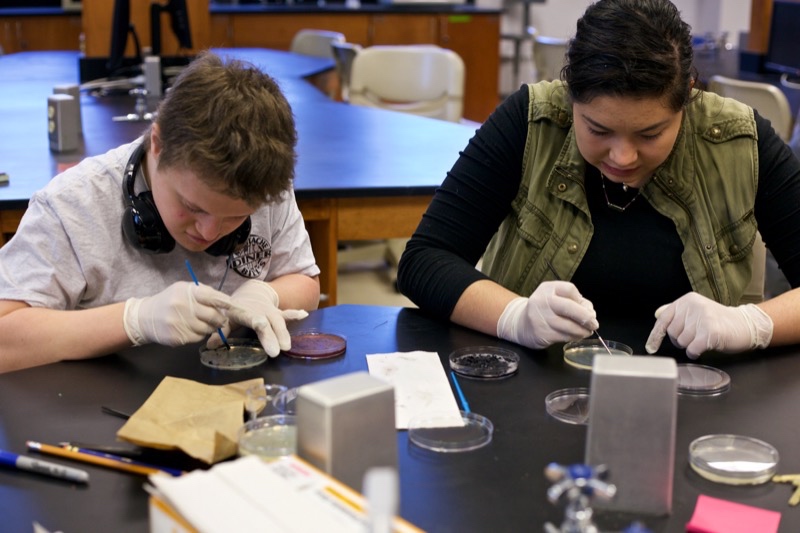Doing Science With Artists Has Made Me a Better Scientist

Editor’s Note: The following blog post is based on the collaborative effort of a group of scientists from Haverford College. To read the published perspective piece by which this article was influenced, please visit PLoS Biology.
“Can I poke a hole through it?”
This question was asked to me during a science outreach experience where artists with intellectual and developmental disabilities worked alongside college students in an undergraduate laboratory at Haverford College to create BioArt. We were painting the bacteria, Streptomyces,—which can produce a wide range of pigments—onto petri dishes filled with agar medium.
In my undergraduate biology education, I had always been taught that you shouldn’t puncture the agar in a petri dish. As someone who was generally nervous about “messing up” things in the lab, I hadn’t really pondered why that was the case.
I thought about it for a minute longer, and then asked my peer—a fellow biology student and participant in the outreach experience—to see what she thought. Although our gut reaction was to say “no”, we ultimately decided, “why not?”. After all, we were trying to create art, not follow a protocol.
The result of that piece of BioArt was spectacular. The bacteria grew all around the agar, creating a pink-tinted three-dimensional sculpture in the petri dish!
During this particular science outreach experience—which spanned the course of a few weeks—we talked about lab safety, painted Streptomyces onto agar, looked at objects under the microscope, and filled our lab notebooks with drawings and writings. We then took what we learned in the lab and went to the artists’ studio where we created multimedia art representations to emulate the Streptomyces “paintings” that we made in the lab.

Pictured above, Lindsey Lopes, creating BioArt with artist, Jacob. Photographed by Caleb Eckert.
Creating BioArt alongside artists with intellectual and developmental disabilities altered the course of my undergraduate science experience by facilitating a new level of creativity and exposing me to a different kind of questioning. Entering a professional art studio (for my first time ever!) was initially anxiety-provoking, but helped me to understand the experimentation that is a part of the artistic process and the similarities between science and art.
I happened to be doing this BioArt experience at the same time that I was conducting my undergraduate senior thesis. Rather than taking a more rigid laboratory course,—where I would follow a specific protocol each day of lab in order to achieve an expected result—during my thesis research I had the opportunity to explore an area of research and create my own project. My project was centered around exploring how stress influences larval zebrafish decision-making behavior, and a crucial component was to ensure proper cortisol measurements. Cortisol is a hormone that is used by many species, including zebrafish and humans, to signal stress. Nevertheless, my first few times completing the cortisol extraction and measurement protocol were unsuccessful. No matter how hard I tried, I could not detect any cortisol present in my samples.
My advisor emphasized to me that this was normal in research. Many protocols require troubleshooting. However, troubleshooting was relatively new to me. I was lucky enough to have done a few short-term research projects that used techniques and protocols that were not as tried-and-true as what I had experienced in laboratory courses, but with those, I had always troubleshooted alongside a team of people.
My coursework had not prepared me to be as flexible and creative in the lab as I needed to be.
The BioArt science outreach project is where I really learned to be creative in the lab, and willing to try new things. While I was troubleshooting my protocol, I often thought back to working with the artists in the lab, and their questioning of different “rules” relating to the protocol of streaking bacteria. I also thought about my time in the art studio, where I was constantly pushed outside my comfort zone, and watched the artists experiment with mixing paints, glue, ink powder, and objects like beads and shells to create art. I thought outside the box when troubleshooting the protocol—much like the artists did as they punctured agar and mixed different colors—and thought deeply about what the purpose of each step was, in order to identify which steps may need to be adjustment, repetition, or even removal.
Ultimately, I did not perfect the protocol in the few months I had remaining in the lab. I did, however, exercise my ability to be flexible and creative in the face of a challenge. I also learned how to use some of the skills that I had learned while doing science outreach in my everyday research. This has stuck with me, even today, when I’m working in the lab.
